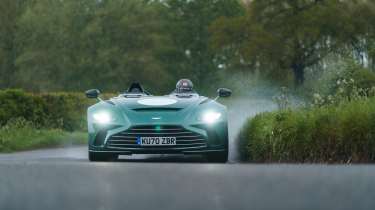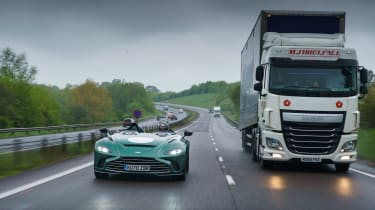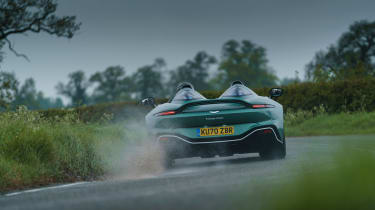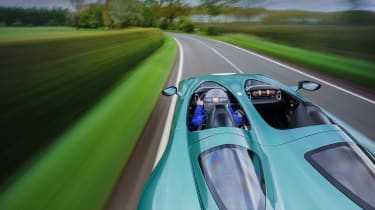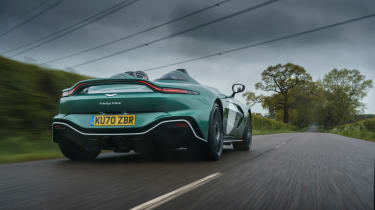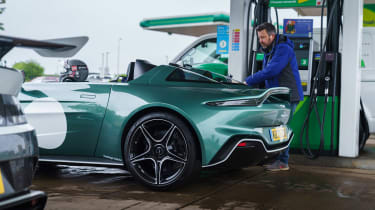Aston Martin V12 Speedster review – open-top rival to the Ferrari Monza
The Aston Martin V12 Speedster will appeal to a very specific buyer looking for a very special take on the open-cabin supercar
There’s a look-at-me element to most sports and supercars. We can all stroke our chins or beat our chests in protest and claim it’s all about the driving but, like it or not, the cars we choose to own are an extension of ourselves and an expression of who we are. They make a statement on our behalves. So, what to make of Aston Martin’s V12 Speedster?
In principle a car with almost 700bhp and an open cockpit, built by one of the sexiest and more storied marques, should be sensational. In reality the Speedster, just like the McLaren Elva, Bentley Bacalar and Ferrari SP1/SP2 Monza, stands accused of being a rather pointless car. One that was created solely to serve a superheated collector market. A market that didn't seem so hot on the genre, at least if McLaren’s need to reduce the build run of £1.4m Elvas (the last of the 149 cars selling in early 2022, from an already revised-down 249 and an original proposed total of 399) was anything to go by.
> Aston Martin Callum Vanquish 25 by R-Reforged 2022 review
Sorry. Perhaps I’m being harsh. There’s certainly nothing new in high-end car companies finding ever more extravagant and extrovert ways of relieving colossally wealthy people of enormous amounts of money. Still, there’s something uneasy about cars that are entirely reliant on the weather, force you to wear a crash helmet, and look like a Yeezy trainer on wheels. Oh, and in the case of the V12 Speedster, cost £765,000. Which, to be fair given production was limited to just 88 cars, was considered by some as something of a bargain in this admittedly warped niche.
I wouldn’t normally start a drive feature in such negative or challenging terms, but I don’t recall ever having such conflicting feelings ahead of driving a new car. Especially driving a new Aston Martin, which is a dream for many people, and rightly so. It doesn’t help that our slot to drive the Speedster comes in the middle of the wettest and most miserable British early summers on record, conditions that only serve to underline the inherent daftness of these roofless, screenless cars, at least in the UK or indeed much of northern Europe.
More reviews
Group tests
- Alpine A290 v Alpine A110 – how much DNA do they really share?
- Ariel Atom 4R v Caterham Seven ‘evo25’: power-to-weight heroes go head-to-head
- Caterham Super Seven 600 v Super Seven 2000
- Levante v T1
- Corvette Stingray v Porsche Cayman GTS v Audi R8 RWD
- Great Ferrari hypercars driven: 288 GTO, F40, F50 and Enzo head-to-head
- Hardcore Ferrari V8 specials go head-to-head
- Lamborghini Aventador Ultimae v Lamborghini Countach
- Lotus Emira v Morgan Plus Four – four-cylinder Brits go head-to-head
- Toyota GR86 v BBR Mazda MX-5: supercharged drop-top battles sports coupe
In-depth reviews
- Abarth 600e 2025 review – Italy gives the Alpine A290 something to worry about
- Alpine A110 review – distinctive, lightweight and unforgettable to drive
- Audi R8 (2015 - 2024) review – the ultimate soft-focus supercar
- Bentley Continental R Mulliner: review, history and specs
- BMW 5-series review – is this still Munich’s anchor model?
- BMW 1-series review – Munich’s Audi A3 rival gains focus
Long term tests
- Abarth 695C Turismo Fast Fleet test – 10,000 miles in the Italian hot hatch
- Alfa Romeo Giulia Veloce Fast Fleet test – 7000 miles in the sharp Italian saloon
- Alpina B10: end of term report
- Alpina B10
- Ford Mustang GT
- Ford Mustang GT
- Ford Mustang GT
- Land Rover Defender 110 Fast Fleet test – 9000 miles in the go-anywhere SUV
- Maserati Ghibli Trofeo Fast Fleet test – 4000 miles in the Ferrari-powered saloon
- Mitsubishi Evo MR 340
Review
- New Aston Martin DBS 770 Ultimate review – 759bhp super-GT driven
- New Bentley Batur 2023 review – can it possibly be worth £1.65m?
- 2023 Chevrolet Corvette C8 Z06 review – the American 911 GT3?
- Kia EV6 GT-Line S prototype review – the EV that shows how it’s done
- BBR Supercharged Mazda MX-5 (ND) 2023 review – tuned 250bhp roadster driven
- MG4 Trophy 2023 review
Reviews
- Abarth 695 75 Anniversario edition 2024 review – a fitting send-off for Abarth’s hot supermini?
- Abarth 500e 2023 review
- AC Cobra 378 Superblower MkIV 2021 review – another V8 Cobra, but with a GM heart this time
- Acura Integra Type S 2024 review – a Honda Civic Type R with added restraint
- Alfa Romeo Giulia 2025 review – get one while you still can
- Alfa Romeo SZ: history, review and specs of an icon
- Alfa Romeo 1750 TBi
- Alpina B3 GT Touring 2025 review – a 190mph alternative to the BMW M3 Touring
When first proposed, the Speedster was to be ostensibly based upon the Vantage. But as the programme progressed it borrowed from the DBS, which donates the front-end structure, engine, suspension and brakes, and also the DB11 Roadster, which provides the pop-up rollover protection system. As for the rest, well pretty much everything aft of the A-pillars is Vantage. Aston doesn’t talk about VH any more, but the smart principles of that engineering philosophy remain.
> Ferrari Monza SP1 and SP2: full details
Looks are subjective, so I won’t waste time painstakingly detailing the Speedster’s styling. What I will say is the height and bulk of modern cars – especially those that are front-engined – doesn’t lend itself to evoking the exquisite lines of, say, an Aston Martin DBR1. Even when painted in a colour scheme that mimics that of Aston’s iconic 1959 Le Mans winner. Midway through the day, it strikes me that in profile the Speedster looks like someone who spends a lot of time in the gym working on their arms and chest, but never gets round to leg day. It’s a mental image I have since been unable to forget.
The cockpit is more successful. The central spar takes a little getting used to but sets the tone for what is an undeniably dramatic driver’s eye view. You feel just exposed enough while still feeling nicely hunkered into the car, the only lingering issue being that it’s hard to judge how far away the front wheels are. Design-wise, really neat touches include details such as the one-piece moulded door panels, which incorporate perforations for the hi-fi speakers. There’s the usual mix of modern and classic materials, with pleasing use of saddle leather for the door straps. It’s sometimes hard to see the point of handmade craft in modern cars, but the Speedster offers a satisfying blend without the old-school elements feeling like token gestures. It’s a generally cleaner, less busy environment than the Vantage, and a pointer to what we can expect to see in future series-production Astons.
One of the main highlights of the car is the V12 engine. There’d be something wrong if a twin-turbo 690bhp motor didn’t make an impression, but in this case it’s more about the Speedster-specific changes to this DBS-sourced motor’s character than the appeal and drama of the basic hardware.
Where the DBS pummels you down the road with a monolithic 664lb ft slab of torque, the Speedster feels more intense because it has to work a bit harder, thanks to a reduction of more than 100lb ft in peak torque, with the new 555lb ft peak now arriving at 5000rpm, rather than 1800rpm as in the DBS. It’s a major change in philosophy, and one suggested by Aston’s CEO at the time, Tobias Moers – a man who knows a thing or two about torque after his 20-plus years at Mercedes-AMG. It’s also necessary to prevent the Vantage-sourced ZF automatic from devouring itself (it’s not rated to take the full force of the DBS-spec motor). While it might be a pragmatic solution, it brings a welcome change in character, too.
The effect is impressive, for instead of the DBS’s gravitational and almost entirely linear pull, which eventually tails off some way before the red line, the Speedster’s in-gear acceleration has a more vibrant sensation of building to a crescendo, reaching its peak at a point in the rev range where the DBS begins to fade, then holding that peak for a further 1500rpm. It also has the effect of not immediately overstretching the limits of traction, so while there’s still a ton of grunt at low revs, it’s not delivered in a torrent.
Combined with the slick-shifting paddleshift auto, the Speedster absolutely romps along twisty A- and B-roads, squirming gently against its stability control as each corner opens out and steaming down even the shortest of straights. It’s still a very different sensation to that of a naturally aspirated V12, but there’s a nuanced and welcome difference between the DBS’s one-dimensional delivery and the increasingly tight bear hug you get from the Speedster the harder you work it.
> Aston Martin V12 Vantage review
Your enjoyment of the soundtrack is intermittent to say the least, for much of it gets drowned out by the slipstream beyond 60mph, let alone at the claimed top speed of 198mph. What you do get to enjoy is the muted howl when accelerating in the lower gears, and a drum roll of crackles and pops under braking. It’s nothing like the aria you’d get from working a Ferrari or Lamborghini through the gears (or indeed a Vanquish or V12 Vantage), but it’s a sound packed with potency.
I doubt the novelty of pointing and squirting the Speedster down a windy road would ever truly wane, and once you get beyond the immediate shock and awe of uncorking all that propulsion you find there’s plenty to enjoy about the way it tackles corners.
I’m sure there’s some psychological effects at play when driving this sort of car, but there’s an impression of reduced mass about the Speedster in the way it changes direction and can be aimed at an apex. There’s a brightness to the dynamics and a welcome sense of agility that quickly makes the Speedster shrink around you. It’s easy to place it accurately, even though your sight-lines are less than conventional, with no A-pillars to gauge your positioning on the road.
You can completely disable the stability control, but there’s really no need. Toggling through the dynamic modes reveals Sport+ to offer enough latitude for the rear wheels to just over-rotate under hard acceleration, but enough control to ensure they don’t spin up like Catherine wheels. You still need your wits about you, especially on tarmac still slick from an earlier downpour, but this V12 bobsled isn’t the skittish monster you might expect.
> Aston Martin Vantage V600 v GT8
Any steering corrections you might need to apply are quick flicks and nudges, both because the breakaway is quite sharp, and because the rear comes back into line equally swiftly. And since the stability control isn’t too domineering there’s just enough squirm to make you feel the effect of each and every one of the 555lb ft, but with the reassurance that it will catch itself before things get silly. Commit to the Speedster and it connects you to the action.
The end result is a well resolved car. One that’s a credit to the development team, whose Covid-restricted efforts required them to complete the hard miles through a foul British winter. That effort shows in how well the car copes in tricky conditions, and how complete it feels whether you’re tickling along through town or enjoying the performance on fast open roads.
What you quickly come to realise is that the Speedster is as much for others to enjoy as the driver. It certainly makes for a crazy sight amongst everyday traffic, especially when the skies suggest a downpour is imminent. You might start out driving with a high degree of self-consciousness, but after a few hours you’re not sunk quite so low in the seat and more than happy to make eye contact with those gawping at you. No doubt some of those are calling you all kinds of names (fortunately your crash helmet and the engine swamp pretty much any extraneous noise), but the majority are clearly consumed by a degree of childish glee at what they’re seeing.
The only real downside is that you need to allow at least half an hour for each fuel stop. Not because the Speedster has a colossal tank, but because everyone wants to stop and talk to you, or take a selfie. With the car, I hasten to add. If there was a car perfectly suited to the Instagram Generation, it is this.
Perhaps because of the attention you get whenever you stop or drive through towns or villages, the solitude you experience once out on the open road is especially satisfying. The hi-fi makes as much sense as one of those Honda Goldwings with speakers and a tow bar, but the heater and heated seat mean you are toasty, even as rain flecks your helmet visor. I’d hesitate to suggest the Speedster makes every journey feel like an adventure, but there’s certainly an added dimension to driving it. Probably a little of what it is to ride a fast motorbike, and certainly akin to driving something like an Ariel Atom or Caterham Seven.
There was an added bonus to the V12 Speedster's creation. One that was not officially confirmed until after the Speedster's launch party was cleared away, but made total sense: the new V12 Vantage, based upon the Speedster’s underpinnings. It certainly explained the thoroughness with which this strictly limited-run machine was engineered, while some of the design detailing – such as the full-width bonnet bulge/scoop – hint at clever ways extra headroom has been made for the V12.
With build volumes for the new Vantage kept low at 333 units – lower than the original V12 Vantage's circa 1000 units – Aston avoided the need for space-consuming crush zones in the bonnet – something that made the V12 Vantage project that bit more viable.
The blend of Vantage and DBS characteristics melded together to create the Speedster makes for an interesting machine. One with truly bombastic performance, but one that suits being threaded along entertaining roads. There’s also a pliancy to the car that works very well with the UK’s increasingly flaky road surfaces, so although this means the chassis hasn’t been given needle-sharp responses, it strikes a smart balance that means the car feels more than sporty enough without becoming too busy.
> Aston Martin DBS Volante v McLaren 600LT Spider
Consequently, it’s a car you can relax into and just make progress in, or show some commitment and hustle along nicely. Either way, it doesn’t rely on McLaren or Porsche 911 GT3 levels of attack to feel like you’re doing the car justice.
As for that feeling of less mass I mentioned earlier, well, it’s something of an illusion. Aston was pretty cagey about the weight of the Speedster when it was revealed, but it is certainly in the region of 1750kg, maybe a bit more. That’s hardly in line with the pared-back ethos of this car and the ’50s racer that inspired it, but it is a reflection of the series production cars on which it is based.
Truth be told, Astons have never been light cars, so it stands to reason the Speedster isn’t either, despite the carbon bodywork and lack of a lid. Does it matter? Instinctively, yes, it does, but in reality once you settle into the Speedster’s groove, your expectations shift accordingly. It’s not the last word in anything in particular, except perhaps indulgence on the part of the owners, but focus on how you feel when you’re driving it and there’s less to get hung-up about.
If my opening gambit was essentially a somewhat snarky ‘Why?’ then I suppose the inevitably glib retort from Speedster supporters has to be ‘Why not?’ They’ve got a point. I have no idea who buys these cars and no clue as to what they do with them, though I will happily concede that the V12 Speedster is a much better car than I’d imagined it to be.
I’ll even confess to being amused by the novelty of the driving experience, but despite the craziness and the genuine depth of its development, the Speedster still has the dubious honour of being the first Aston I’ve ever driven that I have no desire to own.
I doubt this revelation will cause anyone at Aston Martin to lose much sleep. Nor will it trouble those customers destined to add a V12 Speedster to their collections. This simply isn’t a car for someone like me. And maybe that’s the point.
Specs
| Engine | V12, 5204cc, twin-turbo |
| Power | 690bhp @ 6500rpm |
| Torque | 555lb ft @ 5000-6500rpm |
| Weight | c1700kg (est) |
| Power-to-weight | c410bhp/ton (est) |
| 0-62mph | 3.4sec |
| Top speed | 198mph |
| Basic price | £765,000 |
This review of the Aston Martin V12 Speedster was first published in evo 286. To receive a copy of evo magazine delivered to your door each month subscribe here
